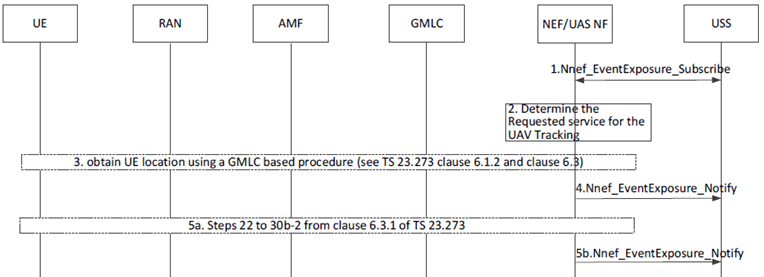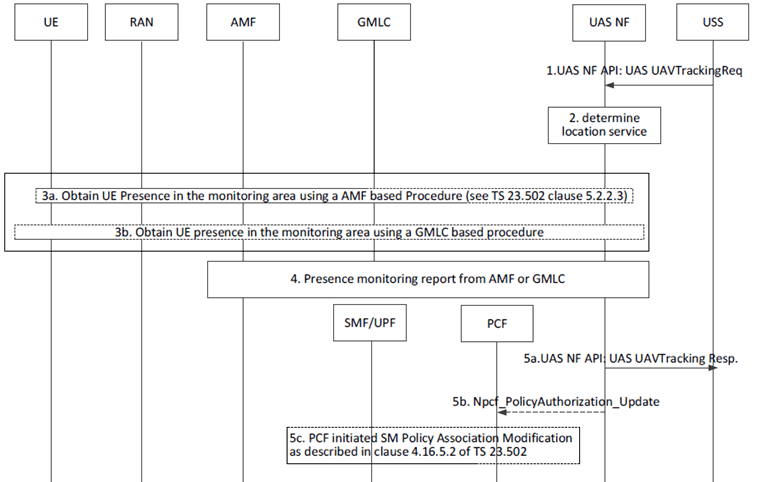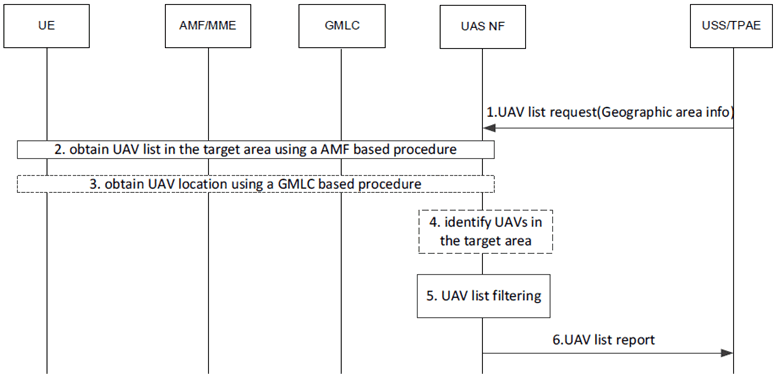Content for TS 23.256 Word version: 19.1.0
1…
4…
4.2…
4.2.3…
4.3…
4.4…
4.5…
5…
5.2.3…
5.2.4…
5.2.5…
5.2.5.3…
5.2.5.4…
5.2.7
5.2.8…
5.2.9…
5.3…
5.4…
5.5…
5.12…
5.13…
5.14…
6…
6.2…
6.3…
6.3.4…
A…
5.3 UAV Tracking
5.3.1 UAV Tracking Model
5.3.1.1 UAV Location Reporting Mode
5.3.1.2 UAV Presence Monitoring Mode
5.3.1.3 List of Aerial UEs in a geographic area
5.3.2 Procedure for UAV location reporting
5.3.3 Procedure for UAV presence monitoring
5.3.4 Procedure for obtaining list of Aerial UEs in a geographic area
...
...
5.3 UAV Tracking p. 60
5.3.1 UAV Tracking Model p. 60
3GPP network supports the functionality of UAV Tracking via the service exposure support towards USS. The USS invokes 3GPP network service through a UAS-NF for UAV tracking. The UAS-NF acts as an NEF/SCEF and interacts with other network functions (e.g. GMLC and AMF/MME) to support UAV tracking. The USS shall use 3GPP UAV ID (e.g. GPSI) for identifying an individual target UAV. When USS/TPAE initiates UAV tracking via USA NF, it should include an indication of reliable UE location information required in the request. For further details on the architecture reference model, see clause 4.2.
Three UAV tracking modes are supported:
- UAV location reporting mode;
- UAV presence monitoring mode; and
- List of Aerial UEs in a geographic area.
5.3.1.1 UAV Location Reporting Mode p. 61
For UAV location reporting mode, the USS/TPAE that wants to be reported on the UAV location subscribes to the UAS NF with the target 3GPP UAV ID. The USS/TPAE could indicate the required location accuracy, reliable UE location information required and whether it's for immediate reporting or deferred reporting (e.g. periodic reporting). With the request received from USS/TPAE, UAS NF identifies the related NF, i.e. GMLC and trigger existing procedures to retrieve the location report. Then UAS NF reports back the UAV's location together with the 3GPP UAV ID to the USS/TPAE.
5.3.1.2 UAV Presence Monitoring Mode p. 61
For UAV presence monitoring mode, the USS/TPAE may subscribe for the event report of UAV moving in or out of the geographic area (e.g. longitude/latitude, zip code, etc). The request includes target 3GPP UAV ID, indication of reliable UE location information required and geographic area info.
If the requested geographic area info can be mapped to 3GPP defined area, such as a list of Tracking Areas or a list of cells as currently supported by 3GPP network as the Area Of Interest, UAS NF subscribes to AMF/MME for reporting the presence of the UAV in Area Of Interest using existing AMF/MME procedures, otherwise UAS NF subscribes to GMLC for configuring the presence monitoring. Upon receiving the report from AMF/MME or GMLC, the UAS NF notifies USS/TPAE for the UAV presence in the geographic area.
The USS may provide policies or rules to UAS NF based on the received event notification. If the traffic routing policies or rules were provided to UAS NF, when the location of UAV or the UAV presence in the monitoring area matches a policy, UAS NF based on the policy indicates SMF to take the appropriate network layer actions, e.g. revoke the connectivity between UAV and UAV controller. UAS NF considers those policies as active and ongoing instructions from USS without constant or repeated triggers/requests from USS. The traffic routing policy includes 3GPP UAV ID(s) (i.e. GPSI(s)) to identify the UAV(s) and the corresponding network layer actions e.g. revoke the resources of the related C2 communications.
5.3.1.3 List of Aerial UEs in a geographic area p. 61
In this mode, the USS/TPAE requests UAS NF for a list of the UAVs in the geographic area and served by the PLMN (i.e. no 3GPP UAV ID provided by the USS/TPAE). The request includes geographic area info, indication of reliable UE location information required and indication of one-time reporting by setting "maximumNumberOfReports" to 1. If the geographic area info can be mapped to 3GPP defined area such as a list of Tracking Areas or a list of cells, UAS NF triggers existing AMF/MME procedures to get the UE list within the TAI(s) or Cell Id(s). The UAS NF may include Aerial UE indication as an event filter in the request, that is used by the AMF/MME to separate out the UEs that are actual UAVs based UEs with aerial subscriptions. If the geographic area info cannot be mapped to 3GPP defined area such as a list of Tracking Areas or a list of cells, UAS NF provides a list of Tracking Areas which is larger than the geographic area to AMF/MME to retrieve the UE list within the list of Tracking Areas. Then UAS NF identifies UAVs from the UE list and obtains the location for each identified UAV via LCS procedure toward GMLC. The UAS NF compares the UAV location with the geographic area to identify the UAVs in the geographic area and provides feedback to USS/TPAE. For the UAV list received from the AMF/MME or the UAV list identified with GMLC provided location, the UAS NF performs the filtering by checking for each 3GPP UAV ID reported whether there is match for the corresponding UAV context. The UAS NF may also verify whether the requesting USS is authorized to obtain the location info of the UAV.
In the above UAV tracking modes, UAS NF may need to map the 3GPP UAV ID to 3GPP internal IDs and vice versa. The CAA Level UAV ID may be optionally provided by the UAS NF, if available, to the USS/TPAE during tracking and location reporting of UAV.
5.3.2 Procedure for UAV location reporting p. 61
The following procedures describe the 5GC UAV's location reporting service to USS.

Step 1.
USS to UAS NF/NEF: The USS sends Nnef_EventExposure_Subscribe request to the UAS NF/NEF as described in step 1b-1 from clause 6.1.2 of TS 23.273 for immediate location reporting (i.e. 5GC-MT-LR) and step 1b-1 from clause 6.3.1 of TS 23.273 for periodic, triggered and UE available location reporting (i.e. deferred 5GC-MT-LR). USS should include an indication of reliable UE location information required in the request.
Step 2.
UAS NF/NEF determines the relevant NF, i.e. GMLC for location reporting based on the UAV's capability or network capability, location accuracy etc.
Step 3.
UAS NF sends request to GMLC with the GPSI (i.e. 3GPP UAV ID) provided by USS to retrieve the UE location via the current location services supported by GMLC. The UAS NF/NEF performs 5GC-MT-LR Procedure as described in clause 6.1.2 of TS 23.273 or deferred 5GC-MT-LR procedure as described in clause 6.3.1 of TS 23.273 (up to step 21b-1) depending on whether the request received in step 1 was for immediate location reporting or deferred location reporting respectively.
Step 4.
UAS/NEF NF to USS: UAS NF/NEF provides the UAV location to USS/TPAE in Nnef_EventExposure_Notify operation as described in step 24b-2 of Figure 6.1.2-1, if the request in step 1 was for immediate location reporting. The UAS NF/NEF includes the GPSI in the location reporting message to USS/TPAE as well as the UAV's location information (in the form of geo co-ordinates) which is understood by USS/TPAE (not assuming the knowledge of TA and Cell Id).
If the request in step 1 was for deferred 5GC-MT-LR, the UAS NF/NEF sends Nnef_EventExposure_Notify indicating whether or not the periodic or triggered location was successfully activated in the target UE, as described in step 21b-2 of Figure 6.3.1-1.
Step 5.
For deferred 5GC-MT-LR with periodic or triggered location request steps 22 to 30b-2 of Figure 6.3.1-1 are executed and the UAS NF/NEF provides the location report to USS/TPAE in Nnef_EventExposure_Notify operation.
5.3.3 Procedure for UAV presence monitoring p. 62
The following procedures describe the 3GPP UAV presence monitoring mode operation.

Step 1.
USS to UAS NF/NEF: The USS initiates the UAV presence monitoring request via the Nnef_EventExposure_Subscribe service operation to UAS NF/NEF to subscribe to the target UAV presence events from 3GPP network (e.g. moving in or out of the monitoring area). In addition to providing a GPSI corresponding to the target UAV for the presence monitoring, the request also includes the geographic area info (e.g. longitude/latitude, zip code, etc.), an indication of reliable UE location information required. Optionally, it includes a policy or rule indicating the 3GPP network to take the corresponding action when the Area of Interest (AOI) event report is detected. The policy or rule contains a moving in or moving out event associated with an indication of revoking the connectivity between UAV and UAV controller.
Step 2.
UAS NF/NEF maps the geographical area into an area of interest that is represented by a list of Cell IDs, gNB IDs or TAIs and determines the relevant NF (s), i.e. AMF or GMLC for location reporting based on the UAV's capability or network capability, the geographic area info etc.
Step 3a.
If the requested geographic area info can be mapped to 3GPP defined area and the relevant NF is determined as AMF in step 2, then the UAS NF/NEF maps the GPSI provided by USS to SUPI and provides the SUPI and the mapped 3GPP defined area to the AMF to obtain the UE presence status by reusing the Area of Interest mechanism.
Step 3b.
If the requested geographic area info cannot be mapped to 3GPP defined area and the relevant NF is determined as GMLC in step 2, then the UAS NF/NEF uses GMLC based procedure for configuring the presence monitoring. It is preferrable for UAS NF/NEF to use GMLC based procedure if presence monitoring is needed in a granularity finer than the Cell Id. The UAS NF/NEF invokes an Ngmlc_Location_ProvideLocation Request service operation towards the GMLC including the geographical area of interest for presence monitoring. The UAS NF/NEF may first use AMF based procedure for UE presence monitoring as described in step 3a before invoking GMLC service.
Step 4.
UAS NF/NEF receives the UAV presence monitoring report from AMF or GMLC.
Step 5a.
UAS NF/NEF reports the UAV presence in the geographic area to USS by including its GPSI in the report. The CAA Level UAV ID, if available with the UAS NF/NEF, may be optionally provided in the report.
Step 5b-5c.
[Optional] If policies have been provided to UAS NF/NEF in step1 from USS, when the UAV presence in the monitoring area matches a policy, UAS NF/NEF based on the policy indicates SMF (via PCF) to take the appropriate network layer actions, e.g. revoke the connectivity between UAV and UAV controller, etc. The UAS NF/NEF uses the Npcf_PolicyAuthorization_Update service operation as described in clause 4.15.6.6a of TS 23.502 and provides relevant parameters to the PCF. UAS NF/NEF considers those policies as active and ongoing instructions from USS without constant or repeated triggers/requests from USS. The PCF issues a Npcf_SMPolicyControl_UpdateNotify request with updated policy information received from the UAS NF/NEF about the PDU Session as described in the PCF initiated SM Policy Association Modification procedure in clause 4.16.5.2.
5.3.4 Procedure for obtaining list of Aerial UEs in a geographic area p. 64
This procedure may be used by USS/TPAE to obtain a list of the UAVs in a geographic area and served by the PLMN. The USS/TPAE provides the geographic area information to the UAS-NF. Based on the received information, the UAS NF may either trigger the AMF/MME monitoring event configuration procedure with event ID "Number of UEs present in a geographical area" or the GMLC based location reporting procedure. The AMF/MME may filter the list of UAVs before sending it to the UAS NF (e.g. may filter only based on UE having Aerial subscription), if Aerial UE indication was included as an event filter in the monitoring event configuration request from the UAS NF. The UAS NF performs the filtering on the received list from AMF or MME before responding back to the USS/TPAE. The UAS-NF includes the 3GPP UAV ID and may include the CAA Level UAV ID, if available, for each of the UAVs in the tracking and location response to the USS/TPAE.

Step 1.
USS to UAS NF: The USS/TPAE sends the UAV list request to UAS NF to request UAV identity (e.g. 3GPP UAV ID, CAA Level UAV ID). The USS/TPAE includes geographic area info, an indication of reliable UE location information required and indication for immediate reporting in the request message to the UAV-NF.
Step 2.
UAS NF to AMF/MME: UAS NF decides the AMF(s) based on the geographic area info and obtains the UE list in the target area from AMF by reusing the event "Number of UEs present in a geographical area" with any UE in the event filter. The UAS NF may also include "Aerial UE" indication and/or "PDU session established for DNN(s) subject to aerial service" as event filters. If the target area cannot be mapped to 3GPP network areas, UAS NF provides a TA List which is larger than the target area to the AMF(s)/MME(s) for the list of UEs to be queried. The AMF(s)/MME(s) identifies UEs corresponding to the geographic area info and may also filter out the list of UAVs based on checking for UEs with aerial subscriptions, if "Aerial UE" indication was included as an event filter in the request from UAS NF/NEF. In addition, the AMF(s) may also further identify UAVs that have successfully established PDU session for DNN(s) subject to aerial services, if it was included as an event filter in the request from UAS NF/NEF.
Step 3.
[Optional] UAS NF to GMLC: From the list of UEs generated in step 2, for UAVs that are in target areas that do not map to 3GPP network areas, the UAS-NF then queries the UAV(s) location from GMLC.
Step 4.
[Conditional] If step 3 above was executed, from the list of locations returned by the GMLC, the UAS NF compares the UAV's locations to the target area (provided in step 1 above) to identify the UAV to be included in the report for USS.
Step 5.
For either the UAV list received from the AMF(s)/MME(s), or the UAV list identified in step 4, the UAS NF performs the filtering by checking for each reported 3GPP UAV ID whether there is match for the corresponding UUAA context.
Step 6.
UAS NF to USS: UAS NF responds to the USS/TPAE with the list of filtered UAVs (step 5). The CAA Level UAV ID, if available, may be provided by the UAS NF in the response message to USS/TPAE. If the USS performed the UUAA of the UAV, or the UAS NF is configured to know the USS is authorized to receive such information, then the 3GPP UAV ID is also included.